________________
The Main features of Mahāvīra's contribution
2. 5 mahāvratas were formulated in the later days, possibly by or around the time
of the Dasavaikālika, for which see Dixit, Early Jainism, p. 28. Thus the Pār. svans also came to possess 4 vows in due course, but Uttara XXIII is a text
of the late canonical age. 3. All the subdivisions of 8 main karma prakrtis came to be developed in the
later canonical days, whereby the Jainas made up a rule that a sage is not assured of his qualification for liberation unless kevala Jñāna-darśana dawns to him upon destroying all the 4 types of ghātika karma. Kevala jñāna-darsana is the capacity to enable a sage to perceive at any time all the phenomena occuring in the universe in the three tenses of time immediately by his own ātmā without employing the other media of perception, which is an absolute impossibility in reality. Thus the sage who can destroy all the 4 types of ghātika karma is said to be possessed of the knowledge of 14 Pūrvas which are said to have been lost by the end of the canonical age. This naturally drove the Jaina theoreticians to solve the Jaina problem of literation in the mythological plane. All this occurred because vaira which is the efficacy of retribution involving violence came to be replaced by karma which is the principle of determining the whole make-up of an individual being. In the context of karma theory, violence there fore became a minor factor to produce certain kinds of karma. MV's original thesis that apărambua is the sole pathway for liberation had to therefore give way to the proposition that the eradication of the total types of karma alone leads to liberation. No change has however taken place in the basic rules of ascetic discipline since the time of MV, because karmic eradica.
tion is after all effected by the same method of penance alone. 4 Cf. Jacobi : S. B. E., vol. XLV, p. xxxiii. Basham: The History and Doctrines
of thc Ajivikas, p. 5. Dixit : "The Problems of Ethics and Karma Ductrine as
Treated in Bhagavatisutra", Sambodhi, II-3, p. 2 5 In the Sutrakyta I occur the expressions like “kammam khavai', e.g. 1. 2. 1. 103.
or 'udiana-kammă', e.g. 1. 5. 1. 317. The concepts as such cannot yet be present in this age, for the notion that karma is the matter begins to be expressed
in the form of rajas or in the forms of mala in the Sutrakyta I opwards. 6 Basham considers that the animist theory gave rise to the evolution of these
theories. See Basham, ibid., p. 5 7 Gofāla had his predecessors, for which see Basham, ibid., pp. 94ff, 8 See Basham, ibid., p. 243 9 See Basham, ibid., p. 109 10 See Basham, ibid., pp. 118ff, 11 See also Basham, ibid., p. 123 12 See also Basham, ibid., pp. 17-18 13 Basham, ibid., pp. 283-4 14 E.g. Acāra I. 2. 3. 92-93 15 Sutrakrta I. 1. 2. See also Dixit, Early Jainism, p. 6 16 E.g. Acara I. 2 17. Acara 1. 2. 5. 127 18 Basham, ibid. p. 109 19 E.g. Ācāra 1. 4.4. 261 20 The positive action of anārambha or akarana that leads one to achieve moksa
should be free of kaşāya and accompanied by the prescribed ethical conduct.
Jain Education International
For Private & Personal Use Only
www.jainelibrary.org




